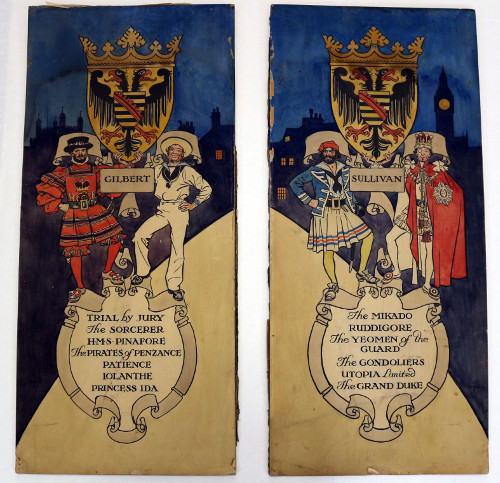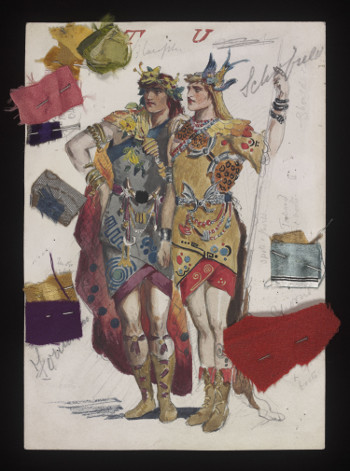Archives Hub feature for October 2016
Browse collections relating to libretti on the Archives Hub.
Browse collections relating to opera on the Archives Hub.

The D’Oyly Carte Archive is one of the jewels in the crown of the V&A Theatre and Performance collections, and is one of the most significant archives in the world relating to the operas of librettist W.S. Gilbert (1836-1911) and composer Arthur Sullivan (1842-1900) and their production and management by composer, theatrical agent, impresario and hotelier Richard D’Oyly Carte (1844-1901). Their partnership resulted in some of the most memorable comic operas ever produced, and ranks as one of the most prolific and successful theatrical collaborations of all time.

Given to the V&A by Dame Bridget D’Oyly Carte (1908-1985), the grand-daughter of Richard D’Oyly Carte, we acquired the archive in several tranches. Our curator of popular entertainment spent many long days at the Savoy Hotel (home both to Dame Bridget and the materials), listing and boxing them up prior to the first acquisition. The archive covers the span of the working relationship between the three. Boasting materials spanning over a hundred years it is one of the most eclectic in our collections, with materials covering all aspects of the workings of the company and including some items you might not reasonably expect to find in your average theatre company archive: Crimean battlefield relics and a box once containing a marzipan pirate’s hat immediately spring to mind!

The collection also includes prompt scripts, correspondence, photographs, original costume and set designs and promotional artwork, legal documents, business books, cuttings albums, music sheets and related ephemera and objects concerning D’Oyly Carte’s production of operas by Gilbert and Sullivan and other composers and librettists, and his general business affairs.
Born in London, Richard D’Oyly Carte was a musician who started his career working in his father’s music publishing and instrument manufacturing business, and had his own operatic and concert agency by 1874. It was as the manager of the Royalty Theatre in 1875 though that D’Oyly Carte began his association with Gilbert and Sullivan, commissioning Trial by Jury from them for the theatre, having seen their first work Thespis, or the Gods Grown Old at the Gaiety Theatre in 1871.

In 1876 D’Oyly Carte formed the Comedy Opera Company in order to produce more work by Gilbert and Sullivan. The Sorcerer, their first full opera in collaboration, opened in 1877 at the Opera Comique, leased by D’Oyly Carte for the production. Following this came H.M.S. Pinafore (1878) which was such a success that it prompted the three to form a new partnership, eventually known as the D’Oyly Carte Opera Company. The success of the production and their desire to combat unauthorised productions of their work in the USA brought about the Company’s first American tour. Their following two works; The Pirates of Penzance (which premiered in Paignton, New York in 1879 prior to its London opening in 1880) and Patience (1881) were the final operas staged at the Opera Comique.

In 1881 D’Oyly Carte built the Savoy Theatre which opened with a transfer of Patience from the Opera Comique. Subsequent Gilbert and Sullivan operas premiered at the Savoy; Iolanthe (1882), Princess Ida (1884), The Mikado (1885 – the profits of which funded the building of the Savoy Hotel), Ruddigore (1887), The Yeomen of the Guard (1888), The Gondoliers (1889), Utopia, Limited (1889) and The Grand Duke (1889). The duo’s operas became known as the Savoy Operas.

The partnership disbanded in 1890 following a legal dispute between Gilbert and D’Oyly Carte over the payment of maintenance costs for the Savoy Theatre. Sullivan sided with D’Oyly Carte, who went on to produce Sullivan and Julian Sturgis’s opera Ivanhoe (1891) as the inaugural production for his newly built Royal English Opera House. Gilbert and Sullivan were reconciled in 1893 and wrote Utopia, Ltd, and their final collaborative work was The Grand Duke (1896).
Without D’Oyly Carte’s diplomacy, tact, business acumen and financial skill it is doubtful whether the collaboration of Gilbert and Sullivan could have started again after Thespis, or lasted so long. Without the brilliance of the operas, D’Oyly Carte would not have been able to build the Savoy Theatre in 1881 to stage their hugely successful works, or the Savoy Hotel he built on the adjacent site in 1888, or the Royal English Opera House, now the Palace Theatre that he opened in 1891. The collaboration of the three men resulted in worldwide success, the foundation of a British style of comic opera, and a remarkable archive that is catalogued online and can be consulted by appointment at the archives of the V&A’s Department of Theatre & Performance.
Veronica Castro
Assistant Curator, V&A Theatre and Performance Collections
The Victoria and Albert Museum
Related:
Explore the D’Oyly Carte Archive (ca.1850s-1980s) collection on the Archives Hub.
Browse all the V&A Theatre and Performance collections on the Archives Hub.
All images copyright The Victoria and Albert Museum and reproduced with the kind permission of the copyright holder.
